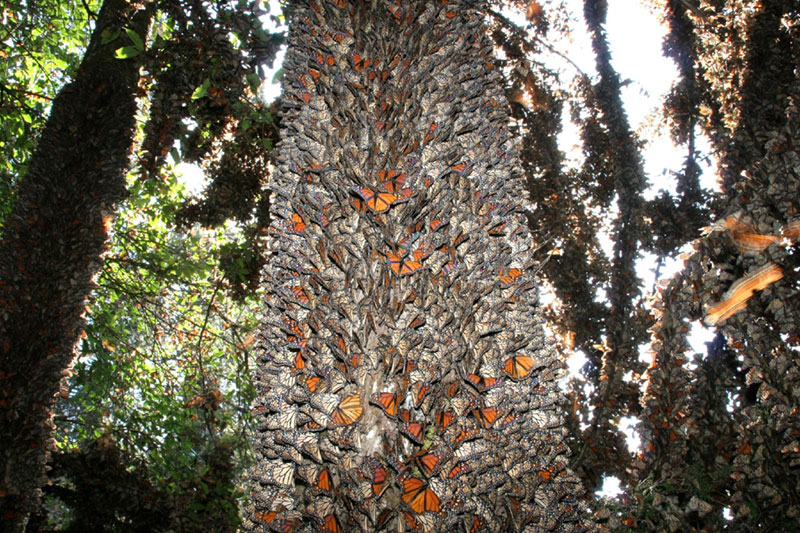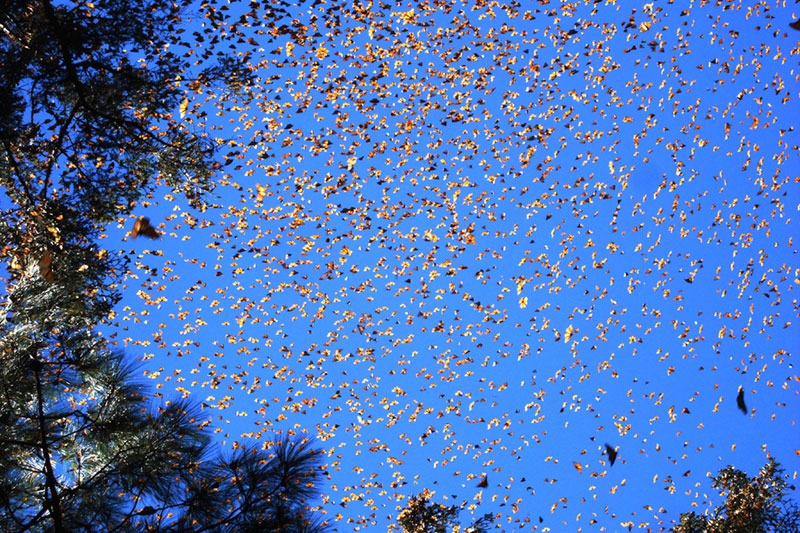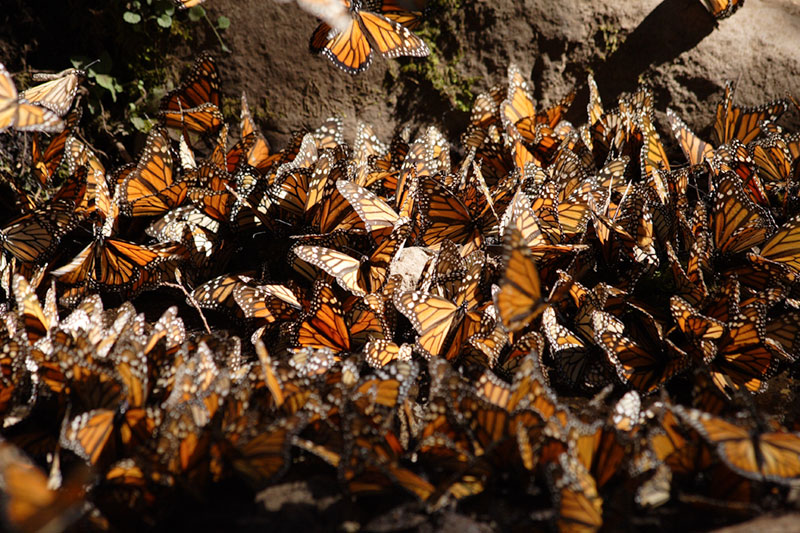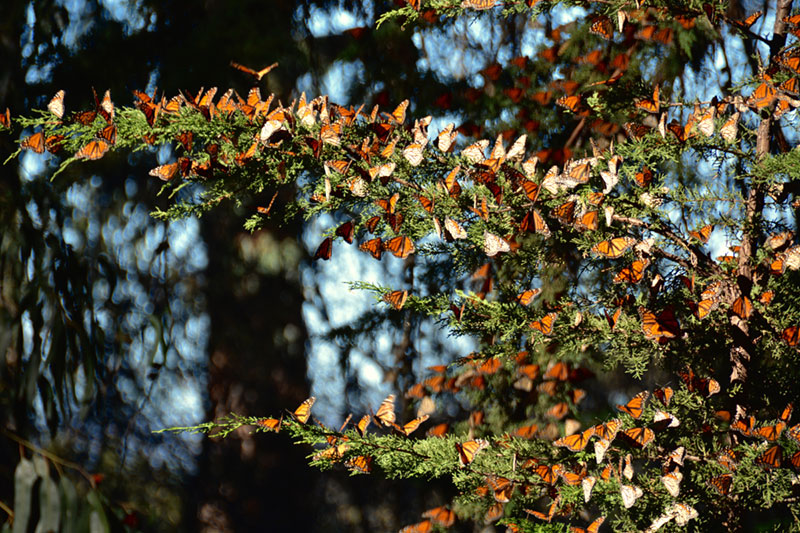“The first time I ever saw them was in February of 1977. We were walking along a road and it was overcast and nothing was moving. Then all of a sudden the colour of the forest changed from green to grey and I realised I was looking at a wall of monarch butterflies. It was just an incredible experience, and at that moment I said: ‘my god, the whole gene pool is staring me in my face’. “

What Professor Lincoln Brower is describing is the Mexican overwintering site of the North American monarch butterfly, Danaus plexippus, the discovery of which ended decades of attempts to understand the butterfly’s unique migratory process.
Well, understand it as best as science currently allows.
The site had been located two years earlier by Ken Brugger and Cathy Aguado, as the result of a butterfly tagging programme initiated by the University of Toronto’s Fred Urquhart in the 1930s. Its discovery represented the culmination of myriad speculating and hypothesising by professionals and amateurs alike about where the millions of monarchs observed annually migrating southward, east of the Rocky Mountains, spend the winter before their spring remigration back into the eastern United States and southern Canada.
But while it provided an answer to the ‘where’, to this day no one, including Professor Brower in his 50 years of study, has been able to answer the ‘why’, or to a certain extent, the ‘how’.
The migration cycle of the monarch butterfly is “one of the most remarkable biological phenomena in the world”, Professor Brower says. The mysterious thing about it is that the cycle takes three or four or more generations to complete. So the butterflies that spend the winter in the oyamel fir trees in Mexico’s Sierra Madre Mountains are in fact the grandchildren, or great grandchildren, of the butterflies who overwintered there the year before.
How can they know to return to the same site each year, despite the fact they, nor their immediate forebear, have ever been there?

Before we explain what we do know and what we don’t, let’s take a step back to look at how we got to where we are today, or, where Professor Brower was in 1977.
Lincoln Brower developed an interest in butterflies around the age of five, and by the time he enrolled at Princeton University as an undergraduate, he knew he wanted to dedicate his studies and his life to Lepidoptera. The moment that set Brower on the trail of the monarch in particular, occurred in a field in the 1960s, when he tasted a leaf from a milkweed plant, the monarch’s main food source. He was testing a theory that a butterfly’s toxicity to predators was not an innate trait, but the result of what they ate.
“It was just unbelievable, it almost made me throw up!” Professor Brower says of his experiment. But it piqued his interest in chemical ecology, and from here, he took a sabbatical and went to California to collaborate with some chemists to better understand what it was in milkweed that made monarchs unpalatable to their predators. What he uncovered in the process, was much more significant to our story.
“We discovered that milkweeds have poisons in them, and after extracting the poisons from the leaves, we found that different species of milkweed had different chemical fingerprints. And then the light went on in my head: we could use the chemical markings that the butterflies are picking up from the different milkweed plants to trace their movements.”
It was serendipitous that Brugger and Aguado had discovered the monarch overwintering site around the same time, and two years later, after a week of travelling in Mexico, Brower and his colleague William Calvert figured out the secret location. He was then able to use his chemical fingerprint tests to determine “where (the butterflies) were coming from, which milkweeds they ate, and exactly what sort of migration patterns were happening”. It confirmed the species’ “unique, complicated, fascinating” two-way multi-generational migratory process.
The migration cycle goes something like this: almost exactly to the day of the September equinox each year, millions, maybe even billions, of monarchs begin a 2,000-3,000-mile journey from their breeding range in the mid-western states, Great Lakes region, and southern Canada. They fly down through Texas to Mexico over a period of six to eight weeks, arriving in early-mid November. There, they cluster in fir trees on a handful of specific peaks in the Sierra Madre Mountains, around an elevation of 11,000 feet, for the duration of the winter. It is estimated there are probably one million butterflies per hectare (that number used to be much higher, of which more later). Six months after they set off, almost exactly to the day, on the March equinox, they begin flying back the other way. (It was Brower’s chemical fingerprinting that confirmed the butterflies arriving and leaving Mexico were the same individuals). The overwintering generation makes it to Texas, where they find milkweed, feed and lay their eggs, and then die. The new generation takes three weeks to develop, and then resumes the migration, heading north into New England, up to Ontario, to establish the next generation, which completes the round trip back to the autumn breeding range, where another several generations are produced, before the cycle begins again in September.

“The migration of the monarch is unique — and I think it’s unique across the whole animal kingdom — because it involves several generations. And the thing that’s incredible about it is those butterflies have never been to Mexico before, but they find their way to the same trees that their grandparents had spent the winter on the year before. It’s a real mystery.”
Scientists believe they know how the butterflies are able to navigate such long distances to Mexico: their primary tool is a ‘sun compass’, or using the angle of the sun along the horizon in combination with an internal body clock to maintain a south, south-westerly flight path. As a back-up orientation guide, it is believed they use a ‘magnetic compass’, or the angle made by the earth’s magnetic field and the surface of the earth, to point them south on the way to Mexico, and north on the return journey.
But the question that remains is how do they know to navigate to Mexico, and to the very same mountain peaks, and the very same trees, as their relatives several generations removed. Of course, an expert of Professor Brower’s tenure has his own theory.
“My hypothesis — and I think it’s probably right, but it’s awfully hard to get data on it one way or the other — is that there’s so many butterflies, and thousands and thousands of them die each year, and they get incorporated into the soil at the base of the trees. I think there’s some chemical in the butterfly that’s being wicked up from the roots of the trees, into the tree itself, that the butterflies can actually sense when they come through there the following year.
“We have tried extracting from the branches that were covered with butterflies, and branches that weren’t covered, to see if we can find this chemical. There’s some indication that it may be there, but we don’t really have good data yet. I don’t think there’s any other explanation by which they recognise to go back to the same place. Maybe someone else can think of one, but I can’t. I believe it’s just a matter of time before we find a chemical cue.”

But most pressing on Professor Brower’s agenda right now (he retired in 1997 but acts as a Research Professor of Biology at Sweet Briar College in Virginia) is protection of the monarch and its habitat. In fact, it’s been a concern since he first ventured into the Mexican oyamel fir forest in 1977.
“The road we walked on to get to those butterflies was a logging road, and I thought at that point: ‘we better get involved in the conservation of this incredible overwintering phenomenon’.”
Between then and now, Professor Brower says there’s been an 80-90% decline in the number of monarch butterflies overwintering each year. Previously, there was at least 17 colony sites, but in the past few winters, only 11 or 12 have been recorded. Colonies had been known to cover areas up to four hectares each, and support an estimated 50 million butterflies per hectare, but “the numbers of butterflies have plummeted, and the colonies are down to as little as slightly more than one hectare each”.
“I’m old enough now that I can involve myself in politics without being bombarded by people saying scientists should stay out of politics — which I always thought was baloney in the first place, they should be the first people in politics and help make some decisions that are not going to wreck this planet. As a result of the decline in the butterflies I was asked by the Centre for Biological Diversity, and the Centre for Food Safety, and the Xerces Society — which are three really important US conservation groups — if I would help them write to the federal government to petition the monarch to be classified as a threatened species. That petition was forwarded and it’s being acted upon now. It hasn’t been accepted yet by the feds, but what I’d hoped was that whether or not the petition was accepted, it would call attention to the plight of the monarch, and it is doing that.”
There are two main threats to the future of the North American monarch butterfly: deforestation, and the genetic engineering of crops such as corn and soya beans.
“What the forest does is act as a blanket, an umbrella. If you start cutting holes in the blanket and the umbrella that protects the butterflies from getting wet and cold, you’re going to damage the overwintering phenomenon. Over the years there’s just been relentless logging of these forests. I have been involved in the evolution of two separate presidential decrees that protect the butterflies, but unfortunately the disaster is still occurring.”
Meanwhile, “another issue is that in the past 10 or 15 years, agriculture in the United States has become totally industrialised, and corn and soya bean plants have been selected to be genetically resistant to herbicide. Farmers plant the seeds, the seeds come up, the weeds come up, the native vegetation comes up, and then they spray these fields with herbicide and everything is killed except the soya beans and the corn. But what is a weed? All the nectar sources of all the pollinating insects, all the food plants of all the butterflies and other insects. (Genetic engineering) has sterilised the landscape on a scale that’s unprecedented in the history of the Earth, and it is an absolute unmitigated disaster for wildlife.”
And then there are natural disasters, increasingly exacerbated by the above.
“There was a freak storm that occurred on the March 11, 2016 which probably killed at least 50% of the butterflies in the biggest colony.” And the storm was able to kill them because their protection, the fir trees, had been compromised by detrimental forestry practices.
“I think we’re going to see one of the worst years we’ve seen yet when the butterflies migrate back to Mexico this fall, and I’m just hoping they’re going to make it.
“It’s the old story of species extinction where you have generations that are wiped out one after the other until you get down to the point where there’s just not enough of them to sustain the genetic variability or not enough of them to stand up against the probability of being killed. We have been saying all along: don’t cut the forest, keep it intact to protect the butterflies. But this year one of the most important colony areas seemed to be one of the worst hit.
“The biological phenomenon of their migration is in danger, it’s seriously in danger as we talk. Right now it’s a question of how far down can the numbers go before the system collapses?
“It’s a clash of commercial culture with ecological culture, and ecology really needs to win a few battles somewhere, sometime.”
